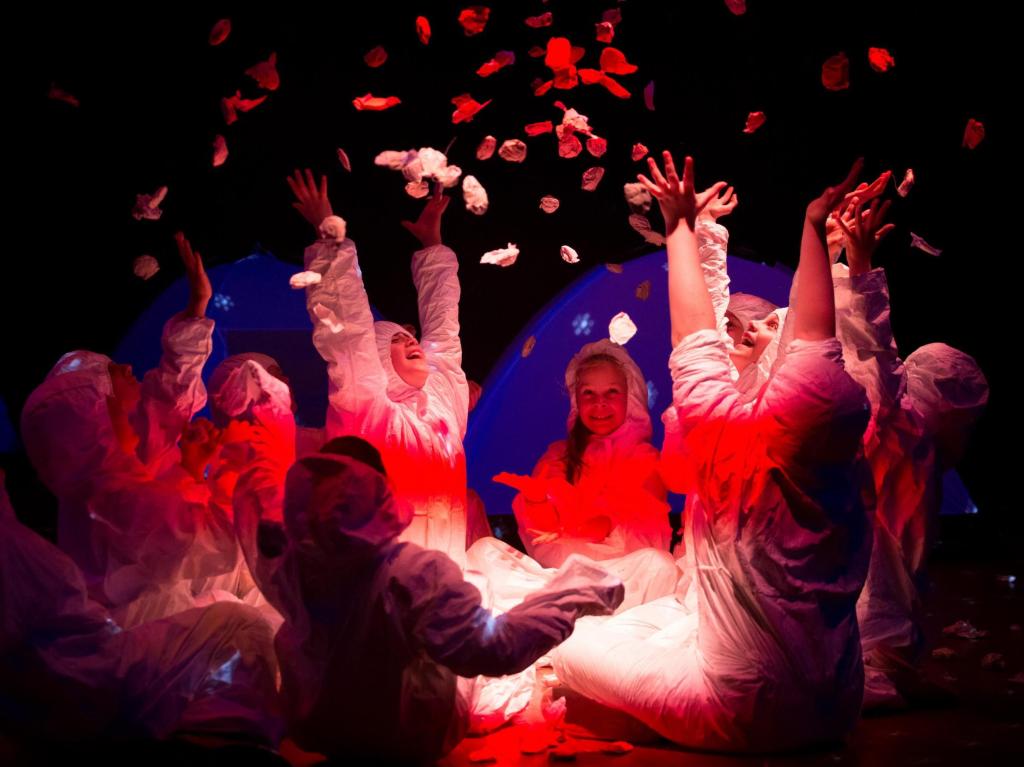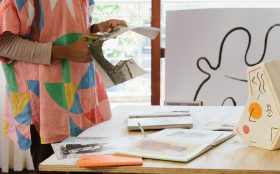Polyglot’s Separation Street, co-created with The Suitcase Royale. Photo credit: Greta Costello.
Engagement with children and young people has a refreshing, alarming effect on the adult world. When children are very young they live very close to their imaginative world, moving easily from real to not-real with little distinction between them. If we as adults are to imagine models of working in different ways; if we are to face constant changes; and experience a society that is pulling apart into many strands; facing choices that are non-binary; facing uncertainty as a certainty; then we need all the imagination we can get. If we can learn to un-learn, to not resist unknowing, to submerge our egos in order to collaborate, we will find a new landscape.
Because of our focus on audiences and participants, on how we can best understand them and allow them the room to stretch and expand within the art created, the work from TYA (theatre for young audiences) is often layered in form. It is sensory and visual, uses multiple intelligences, creates atmospheres and portals to entirely changed environments; it uses sound, music and voice in inventive and abstract ways, shapes texts from real life and sub-culture perspectives, demands constant evolution. The relationship between the audience and the art is responsive and fluid.
Mediation and interpretation by the adult often gets in the way of the adult understanding what is going on for the child. Although this sounds like a contradiction, it is about two languages struggling for clarity. The child’s viewpoint is so easily swamped by adult expectations of what they mean to say but cannot express. The adult becomes easily impatient with the child’s thought process and finishes their sentences or re-interprets what they mean. Listening is not an adult strength. If we can find ways to encourage clarity and confidence in expression without interference, we will see what a difference this makes to our awareness of the child as a human being.
By showing adults children in different contexts we can shift the attitude adults have towards young people of all ages. We can expand the relationship, display the nuance and subtlety that children enjoy, reveal the capability of the child and encourage independence. We can learn to regard young people as contributors rather than recipients, as legitimate actors on the social stage. The extension of this is that the arts created for, with and by young people can be the conduit for greater appreciation and confidence in young people by adults no matter their relationship. The visibility of the work created, and the status of the audience and participants, will gradually get people used to thinking in a new way about the young humans around us. The experience will be reciprocal.
Ontroerend Goed’s Once And For All We’re Going to Tell You Who We Are So Shut Up And Listen very much changed expectations in Australia and internationally for how youth participation could cross over into ‘quality’ theatre. Similarly Anne Louise Sarks and Kate Mulvany’s Medea put a collaboratively devised work driven by actors aged 12 and 14 into the season of one of Australia’s most respected theatre companies.
Fraser Corfield, ATYP
These events have changed minds about what is possible. Artistic limitations are being challenged because adults are invited to witness works that are outside the paradigm of their theatre expectations. The incredible variety within TYA, the huge span of ages we work with, the invisible populations we bring into focus, these things can have an impact not only within our own ghettoes but with a public who don’t know what is possible.
Increasing value—what do we do?
As a sector, the TYA itself can do much to increase the value our art is given in Australia and beyond.
- We can share knowledge about the work people are creating all over the country and through the TYA and Youth Arts Newsletter, run through Theatre Network Australia, we can find out What’s On. This means we must also contribute to the communication. 1
- We can gather our resources and share them—create the cheat sheets that tell the stories and give the data; collect the research and share it; connect with international networks and hone in on profile-raising events and celebrations world-wide. We must do our own work in telling our own story.
- We can make meetings with our key funding bodies, to describe the changes that have been wrought in the landscape especially around Youth Arts and the negative effect of this on our culture.
- We can build collaborations and partnerships outside the arts. We have huge leverage when it comes to benefits to children and young people and we should use it to talk about the art within the work that makes the difference. Young people’s participation in theatre and the arts will continue to bring young people to the fore and to the notice of adults. The works of art that explore this are more and more in demand as they are recognised as ways to engage with new audiences and draw families into spaces they might not have been in before.
- We can make the work. Make more work. Get others, who haven’t before, to make good work for young people of all ages. Critical mass is part of our path to recognition and the work should speak for itself.
- We can take more risks with form—why are we continuing to imagine theatre as a building? Let’s meet our audience coming—go to where the people are, seek out the unusual spaces.
- We can take more risks with content—dare to challenge the conservative view and make a noise about it.
- We can find the champions outside of our own ghettoes who can speak about young people and the arts. Find the forums, the conferences, the opportunities for presentations and stand up and speak.
- We can find the critical rigour within our own practice and seek it from others. Offer appraisal, draw in artistic panels, open up discussion. The Witness project led by Alison Croggon and Robert Reid is one such vehicle, let’s make sure YPA is included in this.
There are ways that those outside our immediate TYA practice can also shift the value of what we do.
- Be brave, take a risk and go and see lots of theatre and art made for, with and by young people. Adults are often scared to go because they feel they are not entitled—it’s not for them unless they have a child with them.
- Include young people in your organisations. Fifty per cent of Victorians are under 25. With that percentage the voice of young people should be considered. Set up consulting groups, collect children’s opinions and enable them to influence policy. There are many examples of how this can work and why.2 Artists have explored many ways that this can be effective and useful across other sectors.
- Enable access: Welcoming children into your institutions may take a shift in thinking, and a shift in attitude across the system. What would that look like? Continuing to ask the question of ‘who is not here?’ starts the thinking around inclusion and access. Cultural Institutions have had to create specific and deliberate portals and spaces for children and families.3 Arts Centre Melbourne has a culture of participation and consistent children’s programming that has grown over the past ten years.
- Validate the young person’s experience as equal to the adult – this is an attitudinal change that removes condescension and enables conversation. Simple rules; listen with interest, allow the time for authentic exchange, don’t laugh when no comedy is intended.
- Understand the importance of cultural experiences for children from pre-birth to adulthood. Even on a scientific developmental level this is important stuff.
- Include children under 15 as audiences in the next National Arts Participation Survey and collect the data on that.
- Include TYA festivals on the Government websites.
[1] Theatre Network Australia provides a link to TYA companies and Youth Arts, to the International Association of ASSITEJ and the national newsletter. www.tna.org.au
[2] The Right of the Child to be Heard
[3] Creative Victoria, Growing Audiences: Engaging Children and Families Summit, November 2017.
This is an extract from the new Platform Paper by Sue Giles, Young People and the Arts: An agenda for change published today by Currency House and to be launched on Friday at the Coopers Malthouse in Melbourne.





